
by NRF User | Mar 30, 2020 | NRF News
This April, hundreds of Rhode Island nonprofits are participating in the first-ever statewide giving day known as #401Gives. Starting at 6:00 a.m on April 1, you can visit 401gives.org and make a donation to one or more of the many participating nonprofit organizations in the Rhode Island community.
What is 401Gives?
401Gives is an initiative of United Way of Rhode Island. Its purpose is to bring a collective voice to Rhode Island’s nonprofit community and deepen the state’s culture of philanthropy. At a time when everyone is feeling the impact of the COVID-19 pandemic, nonprofits rely on the support of their members, visitors and donors like you to keep their missions moving forward.
Whether you decide to make a gift to NRF on April 1, or another organization, we hope you will participate if you’re able. The Newport community needs your help during this time. Together, we can make a difference and help offset the economic impact many local nonprofits are facing.
How can you make a difference on 401Gives Day?
- Visit 401gives.org and search for your organization(s) of choice – we hope you will keep us in mind as you choose from the list of participating nonprofits.
- Check out NRF’s microsite to learn more about what we do and to make your gift, if you choose.
- Like and share our posts on Facebook and Instagram to spread the word to your friends and family who can join the 401Gives movement and support local nonprofits
Questions? Comments?
If you have any questions or would like more information, please contact Development Coordinator Alicia Cipriano at 401-849-7300, Ext. 117.
Thank you in advance for your generosity, for participating in this greater community effort, and for caring about the well-being of all Rhode Islanders!
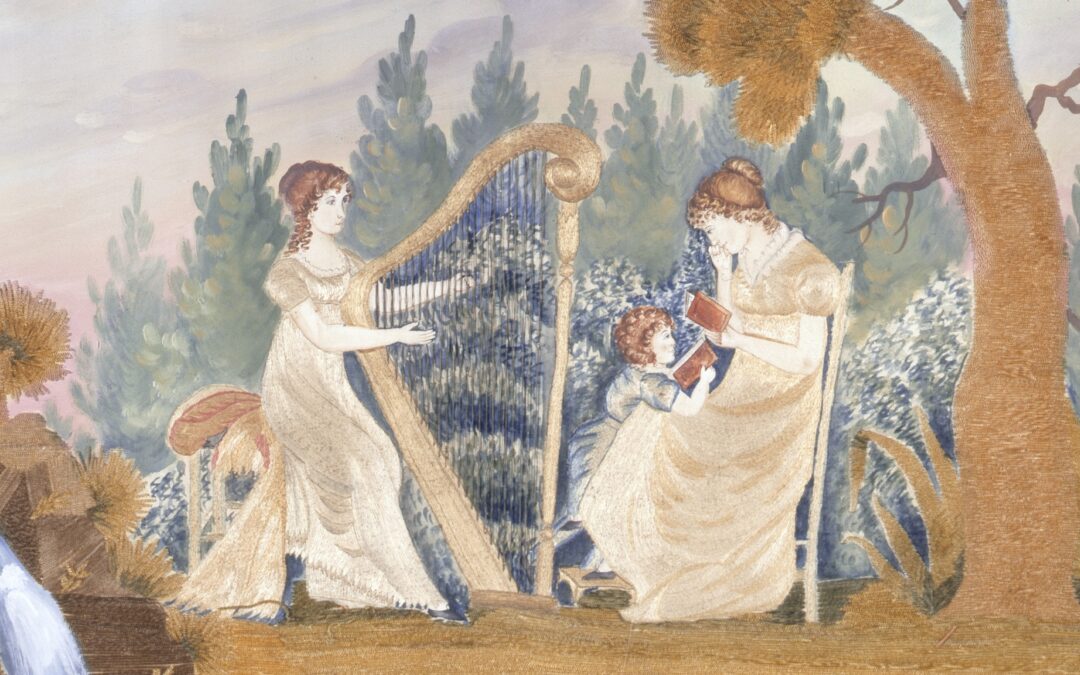
by NRF User | Mar 12, 2020 | NRF News
We’re continuing our celebration of Women’s History Month by participating in the National Museum of Women in the Arts’ #5WomenArtists challenge! The origination of this challenge came from the question, “Can you name five women artists?” When NMWA posed the question, they found that “people struggled and many could not at all—even those who consider themselves well versed in the arts.” The challenge sought to increase awareness for women in the arts by sharing their contributions through social media during the month of March.
Newport Restoration Foundation is honored to have several pieces created by women in our fine and decorative art collections. We’ve spotlighted five of these women artists here, and invite you to see them for yourself when our museums open this spring!
Madame Gres

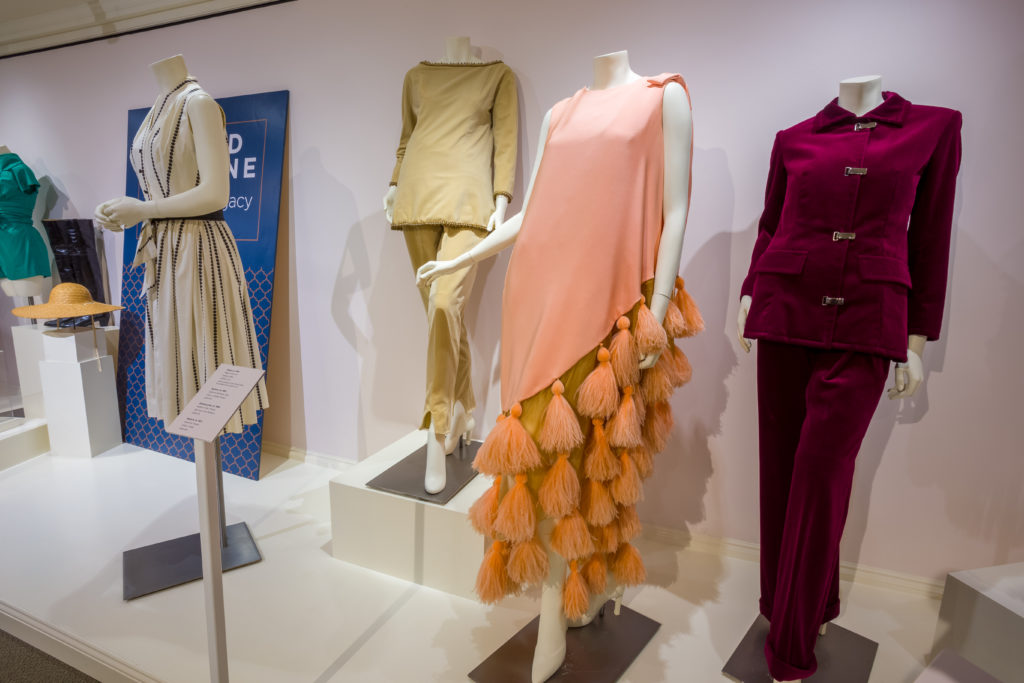
Madame Gres (1903-1993) was one of the leading French couture designers of her generation. Gres was known for her superior use of fabric and materials to create dramatic gowns like this silk and ostrich feather dress, made for DorisDuke circa 1966. This dress was featured in 2019’s exhibition, Beyond Fortune: The Life & Legacy of Doris Duke.
Margarete Heymann
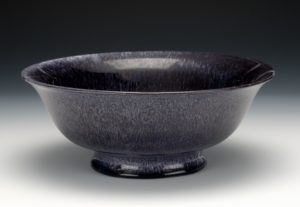
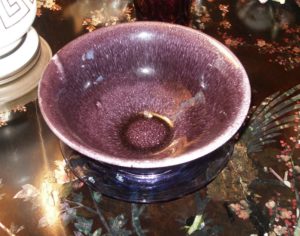
German, ca. 1928
Earthenware, glaze
This glazed ceramic bowl is a striking example of the work of German-Jewish ceramic artist Margarete Heymann (1899-1990), who was one of the first female students of the innovative Weimar Bauhaus. She was the co-founder of the Hael-Werkstätten workshop and created bold, modern designs.
While we are not sure what drew Doris to this particular bowl (it is one of the few examples of modern art at Rough Point), she placed it alongside other mementos that held particular sentimental significance and against the backdrop of her purple-infused bedroom.
Susan Nichols
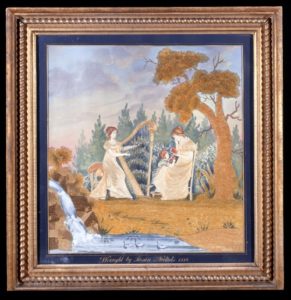
Ca. 1818
Silk, glass, wood, gilt
Doris Duke found this piece in a New York auction house and brought it to Newport, where Susan Nichols once lived with her family on Washington Street. This example of needlepoint is representative of the work of many women in the period who documented their lives, showed off their skill, and created artwork that often became a treasured heirloom passed from mother to daughter. The piece is inscribed in gilt lettering “Wrought by Susan Nichols 1818.” and can be found at the Whitehorne House Museum.
Abigail Whitehorne
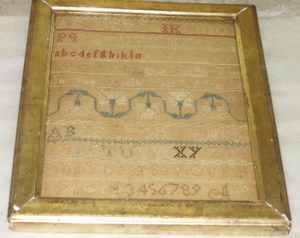
“Abbey Whitehorne’s Sampler Work in Her Tenth Year of Age”, 1804
Linen, cotton, glass, wood, gilt
This sampler, completed by Abigail Whitehorne (about 1794-1875, sister of Samuel Whitehorne, the original owner of Whitehorne House) in 1804 allowed her to sew her way into the historical record. Samplers like these were kept and displayed, and sometimes have found their way into archives and museum collections where they are studied to gain a better understanding of domestic life, the role of girls in the household, and education practices of the time. This piece can also be found in the collection of the Whitehorne House Museum..
Mary McFadden
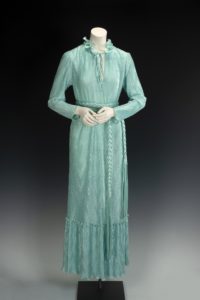
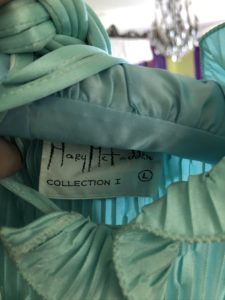
Mary McFadden (American, born 1938) was known for her use of pleats similar to Italian designer Mariano Fortuny. Doris Duke had several McFadden designed pieces in her fashion collection. This circa 1984, turquoise belted caftan is on view in this year’s exhibition, Beyond Fortune: Myths & Truths of Doris Duke.
Want to learn more about the collections at our museums? Click here for Rough Point Museum, Whitehorne House Museum, or find Newport Restoration Foundation at newportalri.org!
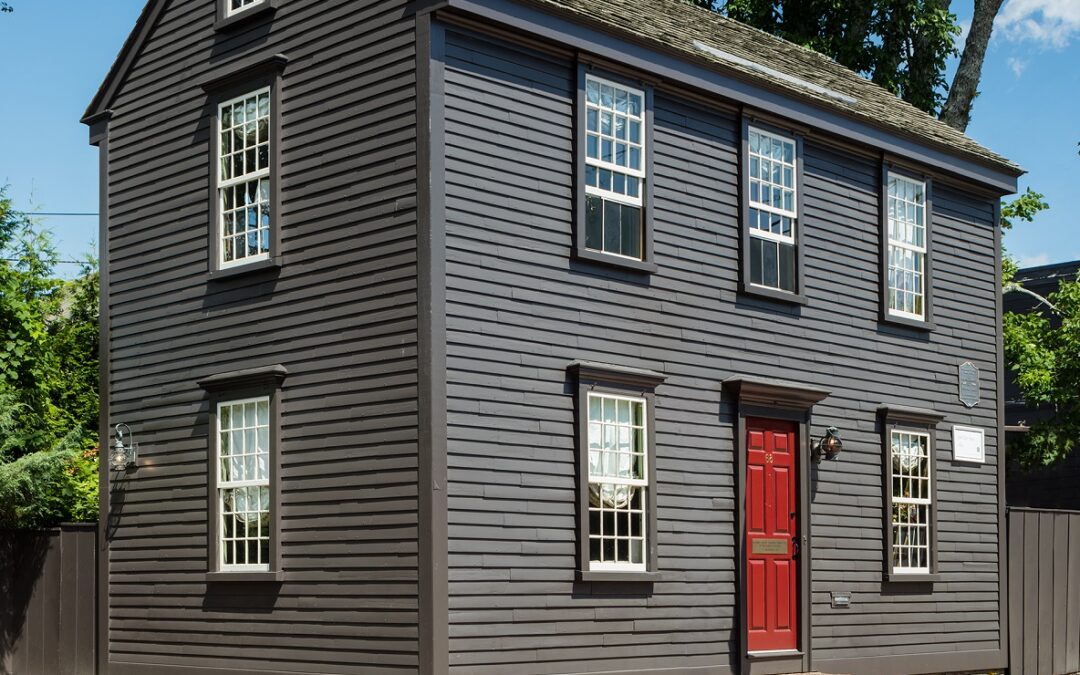
by NRF User | Mar 1, 2020 | NRF News
Throughout the month of May, we have shared stories about our current projects and the people behind the scenes who help make NRF’s preservation work possible. In our community, historic preservation matters. NRF’s collection of 18th and 19th century houses is one of the largest collections owned by a single organization anywhere in the country. Its continued maintenance is one of the most crucial ongoing preservation activities in New England.
We invite you to become part of a community that cares deeply about protecting these resources.
By joining Restoration Partners, our monthly giving program, your gift provides consistent support to the work we do every day to preserve important historic buildings in Newport.
Ten caring individuals have already joined the program this month, and we are grateful for their generosity. Will you join your neighbors? We need 10 more community members to help us achieve our goal of welcoming 20 monthly donors by the end of May.
If you’re passionate about preservation, please consider making your gift this month so we can continue to protect Newport’s architectural heritage.
JOIN TODAY
P.S. Learn more about our preservation work on YouTube! Click here to start watching.
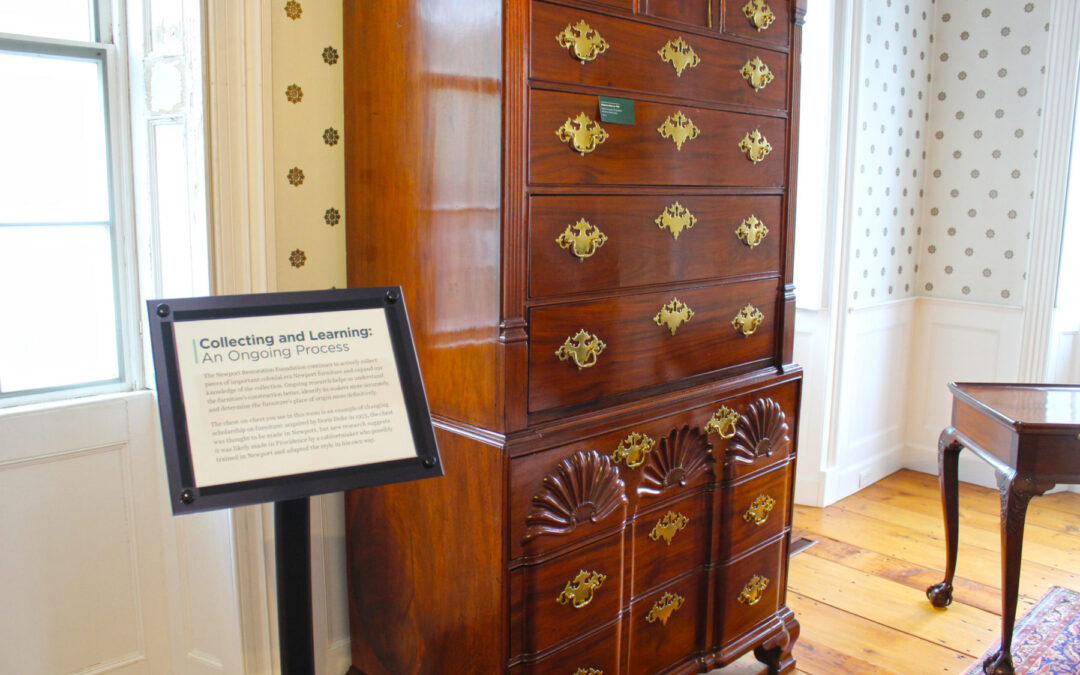
by NRF User | Jan 13, 2020 | NRF News
Newport Restoration Foundation is pleased to collaborate with Christie’s Auction House on a special lecture event for their upcoming Americana Week (January 17 – 24). On Wednesday, January 22 at 4:30 pm, NRF’s Director of Museums Dr. Erik Greenberg will present Furniture Forward: A New Approach to Interpreting Doris Duke’s Furniture Collection at the Whitehorne House Museum in Christie’s Boardroom at their headquarters in New York City. A reception will follow at Christie’s beginning at 5:30 pm.
During Americana Week, Christie’s will hold three auctions (as well as associated programming) that speak to themes of American beginnings, patriotism, diversity and influence. The series begins with the Outsider Art sale that highlights exceptional artists such as Bill Traylor, Henry Darger and William Edmondson. Chinese Export Art Featuring the Tibor Collection, Part II showcases Chinese Export porcelain, specifically famille rose soldier vases, covers, and court lady candleholders. And The Important American Furniture, Folk Art and Silver auction closes the week with an array of extraordinary artworks and objects, including pieces from the collection of the late Ralph E. Carpenter, the renowned collector, curator, and advocate for the restoration and preservation of Newport’s decorative arts and architecture.
The Whitehorne House Museum was NRF’s first museum, opening in 1974, and for many years it served as a domestic house museum. In 2017, the museum closed, as staff, outside scholars, and others reinterpreted the museum collection, focusing more closely on its exceptional collection of 18th-century furniture, much of it purchased by NRF’s founder, Doris Duke, and most of it from Newport in particular or Rhode Island in general. NRF uses the furniture on display to tell important stories of colonial Newport through one of its most prized creations. Staff have also developed a more engaging experience for visitors to the museum, including hands-on objects, a multimedia installation, and other opportunities for visitor engagement. It reopened on May 29th, 2019. Dr. Greenberg’s presentation will address the museum’s recent, interpretive changes while placing them in the broader context of Colonial era furniture exhibition across the country.
When asked about his upcoming talk, Greenberg noted that, “When I arrived at NRF a year ago, our interpretive staff shared with me their plans to reinterpret the Whitehorne House Museum and their desire to bring the ‘furniture forward’ from among the many utilitarian objects and decorative arts in the collection. I was taken with their vision, and have become fascinated by Newport furniture, the people who made it, purchased it, traded it, and the many stories these pieces can tell. I see my presentation at Christie’s as an announcement of our new direction, an appreciation for the work of our talented staff, and an assertion of our plan to evolve and grow into an important institution that celebrates 18th-century, Newport furniture and its stories in the city in which it was made.”
This free event is open to the public. RSVP to the lecture is required. If interested, please respond to Alicia Cipriano by Friday, January 17th 401.849.7300 ext. 117 or at acipriano@newportrestoration.org. Christie’s is located at 20 Rockefeller Plaza, New York, NY 10020.

by NRF User | Oct 16, 2019 | NRF News
As I write this post, fall is in the air, and I am fast approaching the end of my first “season” in Newport. Whitehorne House will close at the end of October, and Rough Point will close in mid-November, though we will continue to hold special programs there until the end of December. When I first came aboard nine months ago, I suggested that this time of year, the close of the season, might be a good time for me to write a blog post…so here it goes.
Early in the season, and still very early in my tenure at NRF, I discovered something that has profoundly shaped the way I think about our museums. You see, at some point in the spring I came to see that unlike my previous museum experience, NRF’s museums (Rough Point and the Whitehorne House Museum) are houses as opposed to buildings created specifically for the purpose of museum exhibition. And so sometime in early April it finally hit me that I work in and with houses!
I recognize that this last point, my recognition that our museums are housed in…well…houses, may seem fairly obvious, and of course that is so. After all, NRF does not hide this fact in its promotional material or even in the job announcement that first drew my attention to this extraordinary institution and its important work. Nor are the buildings that make up NRF’s museums cleverly disguised to hide their initial lives as houses. Nevertheless, one may know something intellectually and still not understand its broader implications. Naturally, I was fully aware that I would get to work in a Bellevue Avenue mansion—heck, I bragged about that fact to my colleagues back in Los Angeles. Still, I assumed that the texture of that experience (of museum work in a house museum) would not be too different from my previous experience working in museums specifically built for exhibitions. As it turns out, I was right, but I was also wrong. I have come to see that my museum practice feels, simultaneously, familiar and somewhat alien to me.
On the familiar side, museum work is museum work. The talented and committed staff of NRF’s museums strive to share information about our collections and about Doris Duke, the founder of NRF and a fascinating woman whose interests and passions continue to make a difference in people’s lives. Like museum professionals everywhere, we exhibit art and artifacts. We share our knowledge through written text, human interaction, and other forms of engagement. We mount special exhibitions and programs to share unseen portions of our collection or to make a new point or argument on a particular topic. We propose and plan new projects to expand our reach and to align our museum work with the interests and needs of the 21st-century museum-goer. And we do our very best to protect our collections from the ravages of time and the environment. While this work is important and valuable, and while I believe our staff is particularly skilled at it, there was nothing that surprised me about it. It all made sense to me. It was the kind of work I have done for nearly twenty years.
Far less familiar were the requirements of doing such work in a nearly 130 year old house. For example, as I began writing this paragraph, three of our staff were in the middle of a discussion about purchasing the right kind of toilet paper to work in our old and delicate plumbing system. Our facilities staff has struggled mightily to create a steady temperature that can protect our objects from the wild fluctuations of the New England climate without making the place uncomfortably cold. In an effort to have Rough Point appear as it did in Doris Duke’s lifetime, our rooms undergo far fewer object change-outs than did the galleries of my previous institution. This practice, which is not unusual in the historic house museum setting, in turn poses its own, unique conservation challenges. And while it is our goal to welcome all who care to visit us, the height of our front gate prohibits large motor coach buses from bringing visitors to this special place, which is too bad, because the most important thing I have come to learn about working in houses is that they really beg to be filled with people.
I know that all museum professionals dream of seeing their spaces filled with people, but that’s not what I mean. I am, instead, suggesting something more personal and emotional. In some sense, I am anthropomorphizing our museums, because I believe (or perhaps feel is a better word) that a house (especially a grand estate like Rough Point) almost demands the presence of people and above all it needs guests.
When I first arrived in January, Rough Point was a quiet, dark, almost haunted place. Most of its exquisite furniture was covered in protective cloth, and the dark and chill of the New England winter hung over the place in ways that were, at once, romantic and eerie. While NRF staff were present throughout the day, with few exceptions, most of our work took place in the third floor offices that used to house the servants’ quarters. Yes, our talented conservators and house cleaners moved from room to room to care for the house and its collections, but the Great Hall, the Music Room, the Solarium, and all of our other spaces were, for hours, or days, or weeks devoid of life. And while I recognize how fantastic this might sound, it felt to me like the house wanted to welcome visitors.
When April 1st arrived and we held our opening of the season party, I found that my suspicions were confirmed. The house came alive, as people admired its grandeur and the beauty of the decorative and visual arts that fill its rooms and walls. Rough Point was abuzz with friends (old and new) all of who admired this beautiful place and the valuable work that the NRF staff does to share the house, its treasures, and its stories with the public. Almost two months later, Whitehorne House experienced the same kind of life and excitement at its opening party, and a few months after that, ninety or so people crowded into the Whitehorne House on a rainy August evening for our Midsummer Celebration. There are no words to describe the joy and energy that permeated the house those few hours. Suffice it to say, Whitehorne House got what it needed, guests.
I should probably close by acknowledging that I recognize the whimsy of my thoughts on this subject. Naturally, I know that our houses neither feel nor think. I can only assume that in talking about our houses and their needs, I am projecting my own feelings and thoughts onto these unbelievably beautiful but ultimately inanimate estates. So perhaps that is what I should be communicating to all of you—not that the house wants you to visit but that I want you to visit us. The presence of guests at Rough Point and Whitehorne House turns our houses into homes. And I appreciate the ways in which our guests’ presence bring about that transformation. Also, I am a big fan of our museums and the staff who work in them. I think that anyone fortunate enough to visit us will be delighted by the experience, and I want as many people as possible to have that feeling. There is still time to visit us this season (the shoulder of the season as my colleagues say), but if you can’t make it now, I encourage you to visit next season. I can’t wait to see you, and the houses are pretty excited at the prospect as well.
By Erik Greenberg, Ph.D., Director of Museums, Newport Restoration Foundation
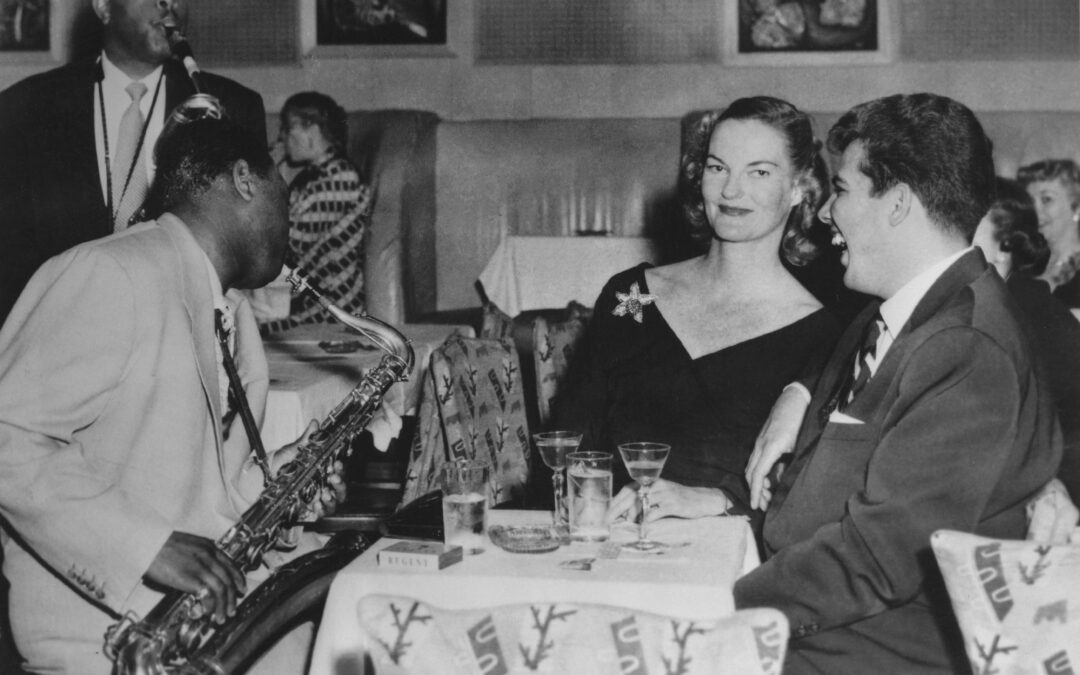
by NRF User | Sep 6, 2019 | NRF News
Doris Duke (1912-1993) was a tobacco heiress, generous philanthropist, savvy businesswoman, discerning collector, visionary preservationist—and amateur musician.
She was a private woman who stayed away from the scrutiny of the spotlight, so it can be difficult to get a look at the woman behind the fortune and the name. This season’s special exhibition at Rough Point, Beyond Fortune: The Life & Legacy of Doris Duke attempts to do just that.
Although Doris did not leave many scrapbooks, letters, or a diary, she did leave a record of her passions and interests through the causes she supported, photographs, and the objects with which she surrounded herself.
Doris Duke was passionate about jazz both as a supporter of musicians and as a musician herself.
She was friends with some of jazz’s greats—including Teddy Wilson (1912-1986), Kitty White (1923-2009), Duke Ellington (1899-1974), and Anita O’Day (1919-2006).
Doris was also dedicated to developing her musical talents. She reportedly practiced daily and took lessons to hone her craft. In the 1950s and 1960s, for example, Doris took piano lessons in New York City from musician Hall Overton (1920-1972).
One of the longest-lasting and significant relationships she had was centered on music. Doris met Joseph “Joey” Armand Castro (1927-2009) in Hawaii in 1951 when she saw him perform with his band, 3 Bees and a Queen. As he recounted, she asked him for private piano lessons and their relationship developed from there.
When Doris purchased Falcon Lair, the former Los Angeles estate of dashing actor Rudolph Valentino (1895-1926), she designed a “playhouse” within the home to have a practice and performance space. After years of preparation, she and Joey Castro launched Clover Records in 1964. The label (along with their relationship) ended in 1966 after only a few projects. Although the relationship ended acrimoniously, there are reports that Doris reached out to Joey before her death.
Although she did not formally become a member of a band, Doris often performed incognito. Besides singing with gospel choirs, Doris also joined Joey Castro’s band on stage and played the piano.
For example, between late 1953 and early 1954, Doris Duke toured Europe with an ensemble including saxophonist Phil Benson, drummer Chick Moncayo, Paul Castro on Bass, and Joey Castro on vibraphone. Doris wore a black wig as a disguise and played piano under the stage name “Dolly Strayhorn.”
While the sound of Doris’s public performances will have to be left up to the imagination (there are no known recordings or photographs of “Dolly Strayhorn”), there do exist recordings of Doris practicing songs and performing with friends. Today, you can hear recordings of Doris Duke playing piano and singing popular 20th-century songs in the Pine Room at Rough Point Museum.














